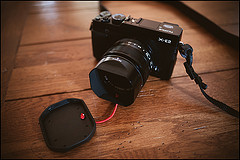My Fuji X Series Cameras & Lenses
/ My fav. at present is The Fujifilm XT1After starting at the top-end with its X-Pro1, Fujifilm has been steadily expanding its X-series mirrorless camera to appeal to a broader audience. With its X-T1, Fujifilm has moved back towards the high-end, offering a fully-loaded mirrorless camera in a weather-resistant, SLR-style body. There's plenty more where that came from - the X-T1 has one of the largest EVFs we've ever seen, numerous manual control dials and, for the first time on an X-series camera, an optional battery grip.
My fav. at present is The Fujifilm XT1After starting at the top-end with its X-Pro1, Fujifilm has been steadily expanding its X-series mirrorless camera to appeal to a broader audience. With its X-T1, Fujifilm has moved back towards the high-end, offering a fully-loaded mirrorless camera in a weather-resistant, SLR-style body. There's plenty more where that came from - the X-T1 has one of the largest EVFs we've ever seen, numerous manual control dials and, for the first time on an X-series camera, an optional battery grip.
The 'guts' of the X-T1 are very much like those found on the recent X-E2. This includes the 16 megapixel X-Trans CMOS II sensor (with on-chip phase detection), EXR Processor II, built-in Wi-Fi, and full HD video recording. The main differences between the X-T1 and X-E2 are the LCD (tilting vs fixed) and EVF (in terms of magnification), the maximum burst rate (8 vs 7 fps, now with focus tracking at full speed), a flash sync port and, of course, the design.
The Fuji X series walk-around cameras that can be adapted for wedding work, editorial work heck, even commercial work.
With these cameras I feel unstoppable. Invincible. I no longer need to carry heavy bulky DSLR around all day – with these cameras I am able to carry an entire kit in a shoulder bag and never tire. With these cameras I rarely miss a photo because I have always have a camera with me.
With these cameras I am stealthy, quick, unobtrusive, silent, a rocket for recording the extraordinary in the mundane of the everyday. My photography changed!
The Fujifilm X-Series range of digital cameras consists of the company Fujifilm's high-end digital cameras and is aimed professional and keen enthusiast photographers. It is part of the larger range of Fujifilm's digital cameras. X-Series itself is not unified by a common sensor size, technology or a lens format. Its main differentiating feature is the emphases on the controls needed by an advanced digital camera user.
I have owned or own at present the following Cameras
Fujifilm X100: prime lens digital camera that uses a custom APS-C sized CMOS sensor and Hybrid Viewfinder, and fixed 23mm F2.0 Fujinon lens. Announced at Photokina, September 20, 2010, the X100 launched globally in March 2011. Succeeded by Fujifilm X100S. SOLDFujifilm X10: advanced compact featuring a 2/3-inch 12-megapixel EXR-CMOS sensor and a high-definition F2.0 wide-angle and F2.8 telephoto Fujinon 4x manual zoom lens (28-112mm). Announced September 1, 2011. Succeeded by Fujifilm X20SOLDFujifilm X-Pro1: Mirrorless interchangeable-lens camera that uses the "X-Trans CMOS" sensor and the Fujifilm XF-mount system of lenses. It was announced in January 10, 2012, and launched in March 2012.SOLDFujifilm X-E1: Mirrorless interchangeable-lens camera which is a slimmed-down version of X-Pro1. The modifications include removal of expensive hybrid finder replaced by an upgraded electronic viewfinder. New EVF uses a 2.36M dot OLED unit, out-speccing the X-Pro1's 1.44M dot LCD finder. It was announced on September 6, 2012.SOLD- Fujifilm X20: is an the replacement of X10 enthusiast compact camera featuring 2/3-inch X-Trans CMOS II sensor, EXR Processor II and a new advanced optical viewfinder. It was announced onn January 7, 2013.
Fujifilm X100S: a redesigned version of the X100 with new sensor-based phase detection, same sensor as Fujifilm X-E2. It was announced January 7, 2013.SOLD- Fujifilm X-E2: successor to the X-E1, featuring X-Trans CMOS II sensor, larger (3") screen with higher resolution (1.04 M), Digital Split Image technology, Wi-Fi. Announced on October 18, 2013.
- 2 Fujifilm XT1 a new camera with a weather-sealed body featuring X-Trans CMOS II sensor and tilting LCD screen. It was announced on January 27, 2014. Also the first X-series camera with an optional battery grip, and the first camera from any manufacturer to fully support UHS-II SD cards.
I have the following Lenses
Fujinon XF18mm F2 R18mm focal length (27mm equivalent) F2.0-F16 apertureSOLD- Fujinon XF35mm F1.4 R35mm focal length (53mm equivalent) F1.4-F16 aperture
Fujinon XF60mm F2.4 R Macro 60mm focal length (91mm equivalent) F2.4-F22 apertureSOLD- Fujinon XF18-55mm F2.8-4 R LM OIS 18-55mm focal length (27-83mm equivalent) (F2.8-F4)-F22 aperture
Fujinon XF14mm F2.8 R14mm focal length (21mm equivalent) F2.8-F22 apertureSOLD- Fujinon XF55-200mm F3.5-4.8 R OIS55-200mm focal length (83-300mm equivalent)
- Fujinon XF23mm F2.0 R 23mm focal length (35mm equivalent) F2.8-F22 aperture
- Fujinon XF27mm F2.8 R 23mm focal length (41mm equivalent) F2.8-F22 aperture
- Fujinon XF 50-140mm f/2.8 R LM OIS WR: A weather-resistant fast telephoto zoom with image stabilization, covering focal lengths equivalent to 75–210mm on full-frame. Officially announced on September 10, 2014.
- Fujinon XF 18-135mm f/3.5–5.6 R LM OIS WR: A weather-resistant, image-stabilized superzoom, covering focal lengths equivalent to 27–202.5mm on full-frame. Officially announced on June 16, 2014.
- Fujinon XF 16-55mm f/2.8 R LM WR: An enthusiast-level standard zoom, covering focal lengths equivalent to 24–82.5mm on full-frame, featuring weather-resistant construction. This lens was originally expected to be available in mid-2014, but has been delayed. Officially announced on January 6, 2015 during CES 2015.











